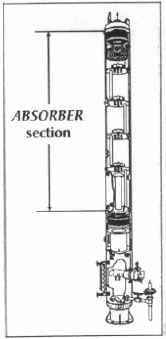نمایش نتیجه 1 تا 10 از 239 نتیجه یافت شده برای recover:
v: I. to take in and make part of an existing whole. 2. to recover liquid hydrocarbons from natural or refinery gas in a gas- absorption plant. The wet gas enters the absorber at the bottom and rises to die top, encountering a stream of absorption oil (a light oil) travelling downward over bubblecap trays, valve trays, or sieve trays. The light oil removes, or absorbs, the heavier liquid hydrocarbons from the wet gas. See bubble-cap tray, sieve tray, valve tray.
to fill part or all of the pore spaces.
n: 1. A vertical, cylindrical vessel that recovers heavier hydorcarbons from a mixture of predominantly lighter hydrocarbons. Also called absorption tower. 2. A vessel in which gas is dehydrated by being bubbled through glycol. See absorb.
n: It refers to the row tube holding thezinky
material during the analysis of drilling fluid. Used to survey the content
of H2S.
a vertical, cylindrical vessel that recovers heavier (longer carbon chain) hydrocarbons from a mixture of lighter hydrocarbons.
ظرف جذب
n: a hydrocarbon liquid used to absorb and recover components from natural gas being processed. Also called wash oil.
واحد بازیابی اسید
واحد بازیابی اسید
v: to treat oil-bearing limestone or other formations with acid for the purpose of increasing production. Hydrochloric or other acid is injected into the formation under pressure. The acid etches the rock, enlarging the pore spaces and passages through which the reservoir fluids flow. Acid also removes formation damage by dissolving material plugging the rock surrounding the wellbore. The acid is held under pressure for a period of time and then pumped out, after which the well is swabbed and put back into production. Chemical inhibitors combined with the acid prevent corrosion of the pipe. acid recovery plant n: plant for therecovery of sulfuric acid from acid sludge.
n: the adhesion of a thin film of a gas or liquid to the surface of a solid. Liquid hydrocarbons are recovered from natural gas by passing the gas through activated charcoal, silica gel, or other solids, which extract the heavier hydrocarbons. Steam treatment of the solid removes the adsorbed hydrocarbons, which are then collected and re-condensed. The adsorption process is also used to remove water vapour from air or natural gas. Compare absorption.
n: A surface phenomenon exhibited by a solid (adsorbent) to hold or concentrate gases, liquids or dissolved substances(adsorptive) upon its surface, due to adhesion.
the attraction and holding of a layer of a chemical on the wall of a formation. Usually held by ionic charge or wetting preference.
n: a method of improved recovery in which alkaline chemicals such as sodium hydroxide are injected during a water flood or combined with polymer flooding. The chemicals react with the natural acid present in certain crude oils to form surfactants within the reservoir. The surfactants enable the water to move additional quantities of oil from the depleted reservoir. Compare chemical flooding, polymer flooding, water flooding.
n: natural gas that overlies and contacts crude oil in a reservoir. Where reservoir conditions are such that the production of associated gas does not substantially affect the recovery of crude oil in the reservoir, such gas may also be reclassified as non-associated gas by a regulatory agency. Also called associated free gas. See gas cap.
the natural gas which occurs with crude oil. It may be free or dissolved. When it occurs as free gas, it may be called unassociated gas.
گاز همراه
Oil and gas reservoir with a gas cap. Gas production from these reservoirs may be restricted in order to preserve the gas cap energy and ultimate recovery.





